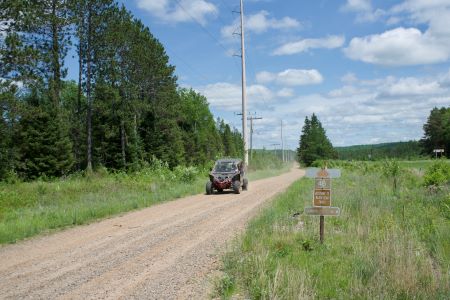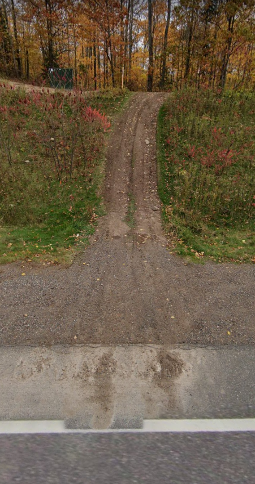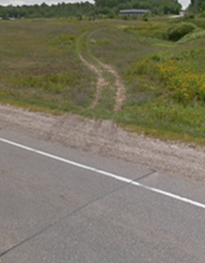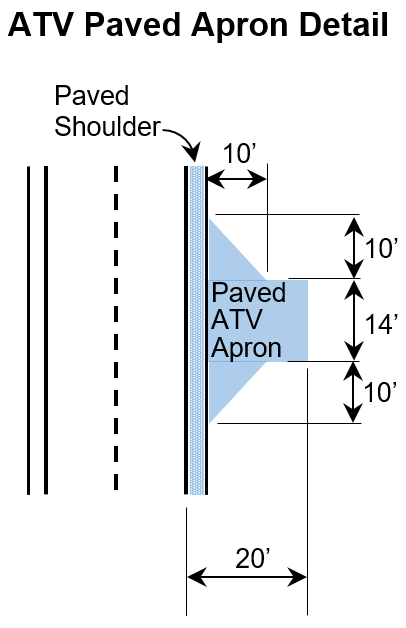
WisDOT may permit an ATV trail within state highway right of way (ROW) if sufficient space is available and it would not adversely affect the safety, maintenance and operation of the highway.
A
DT1504 permit is required and a municipality, county or other governmental agency must be the applicant. Permit requirements are listed in
WisDOT's Highway Maintenance Manual 09-10-11, section 6.3. Go to the
state highway connection permits webpage for more information on the permitting process.
ATV route or trail crossings of state highways
Generally, ATV operators should look for existing driveways, local roads and permitted trail crossings when crossing state highways. This offers the safest path, and it is always the best practice for operators to plan ahead and know locations of legal crossings along their route. Below you will learn more about what to look for and also where there may be some exceptions.
The law and roadway crossings
Wis. Stat. s. 23.33 establishes many requirements for ATV operators including how to cross any type of roadway. At any location where crossing the roadway with an ATV is legal, and no obstructions such as curbs, a raised median, or fence prevent a safe and quick crossing,
s. 23.33(4)(d)1., requires the operator to:
- Stop completely prior to crossing,
- Yield to all pedestrians and vehicles of any type using the roadway, and
- Cross in the most direct manner possible.
While the law covers operator behavior, it does not establish the rules about where roadways may be crossed. Those issues are dealt within the highway-related statutes of Wisconsin law. In general, the authority charged with maintaining the highway controls where drivers and people can enter and exit the roadway, including to cross. For town roads, village/city streets, and county highways, the town, municipality, or county will control access to the roadway. State highways are regulated and controlled by WisDOT, which is charged with establishing and maintaining the state highway system.
WisDOT sometimes owns the rights to enter the highway from lands, and often controls access to state highways under Wis. Stat. ss. 84.09, 84.25 and 84.295. It is illegal to enter and cross one of those highways except at an authorized location.
Identifying a safe crossing
Most ATV operators may not know what access restrictions are on state highways. So WisDOT and DNR have developed some basic guidelines to help ATV operators legally cross state highways in the safest manner possible.
-
Look for existing driveways, local roads, and permitted trail crossings. These locations have been authorized by WisDOT. Driveways and road/street/trail connections are reviewed by WisDOT staff for engineering standards such as spacing and proper sight distance. It is better for ATVs to cross at these authorized locations versus other locations, especially on 55 mph highways with high traffic volumes. Motorists expect vehicles to enter and exit the roadway at these known access points. ATVs (and snowmobiles) crossing at unauthorized locations have a higher likelihood of being involved in a serious or fatal crash.
-
Crossing at non-driveway or road locations. WisDOT understands that ATVs operated by farmers, surveyors, utilities, etc., will need to cross a state highway at a location other than a driveway or road to get from one field to another or from one side of the highway to the other. As long as there is low-volume traffic, sufficient sight distance, and no damage done to the ROW, WisDOT will not take steps to prevent these crossings. When safety and highway maintenance are compromised, then WisDOT will take action to block ATV access and seek law enforcement assistance if needed.
Operators' role in protecting public assets

 In addition to reducing the risk of a crash, another important reason for ATV operators to cross state highways at existing driveways, local roads, and permitted trail crossings is to minimize highway ROW damage. When ATVs destroy vegetation or cause rutting, it may lead to embankment erosion and clogged ditches. If ATVs deposit loose gravel and dirt onto the highway surface, it may lead to safety issues, especially for motorcycles.
In addition to reducing the risk of a crash, another important reason for ATV operators to cross state highways at existing driveways, local roads, and permitted trail crossings is to minimize highway ROW damage. When ATVs destroy vegetation or cause rutting, it may lead to embankment erosion and clogged ditches. If ATVs deposit loose gravel and dirt onto the highway surface, it may lead to safety issues, especially for motorcycles.
On the right are pictures of illegal crossings and the resulting damage. If the operator(s) responsible for the damage cannot be found, then taxpayer dollars must be used for repairs, which reduces funding that could be used to perform regular highway maintenance. If the operator(s) can be identified, then they may be liable for up to three times the cost to repair the damage under Wis. Stat.
s. 86.02.
For everyone's safety and well-being, WisDOT recommends that ATVs cross state highways at existing driveways and road/street intersections.
Are permits needed for ATV crossings?
WisDOT permits
are not required in the following situations because vehicular crossings already exist:
- At town, village, city or county road crossings. For example, ATV routes and trails crossing state highways.
- From a driveway on one side to a local road on the other side (or vice-versa).
- From a driveway on one side to a driveway on the other side.
WisDOT permits
are required in the following situations:
- Where no current vehicular crossing currently exists. For example, a new trail crossing from public/private property to public/private property.
- At a T-intersection where a new trail on public/private property would cross a state highway to a local road.
- Fixing or making improvements to an existing trail connection.
- Any time excavation, work, or improvement installation occurs in the ROW

WisDOT will require installation of a paved apron where an ATV trail connects to the roadway of a state highway. An apron is needed to prevent maintenance issues such as gravel or mud deposits on the roadway surface and to reduce the risk of damage to wing blades when plowing snow. WisDOT may waive or temporarily suspend this requirement if appropriate.
A detail drawing will be required as part of the permit. An example is provided showing typical apron dimensions. These dimensions may vary depending on topography, geology, and other local conditions. Consult with WisDOT for apron requirements in areas that have curb and gutter.
Contact WisDOT
Contact a transportation region office for specific questions regarding ATV trail permits.
The link below contains a map of the state with region boundaries and office contacts.
Contact a transportation region office